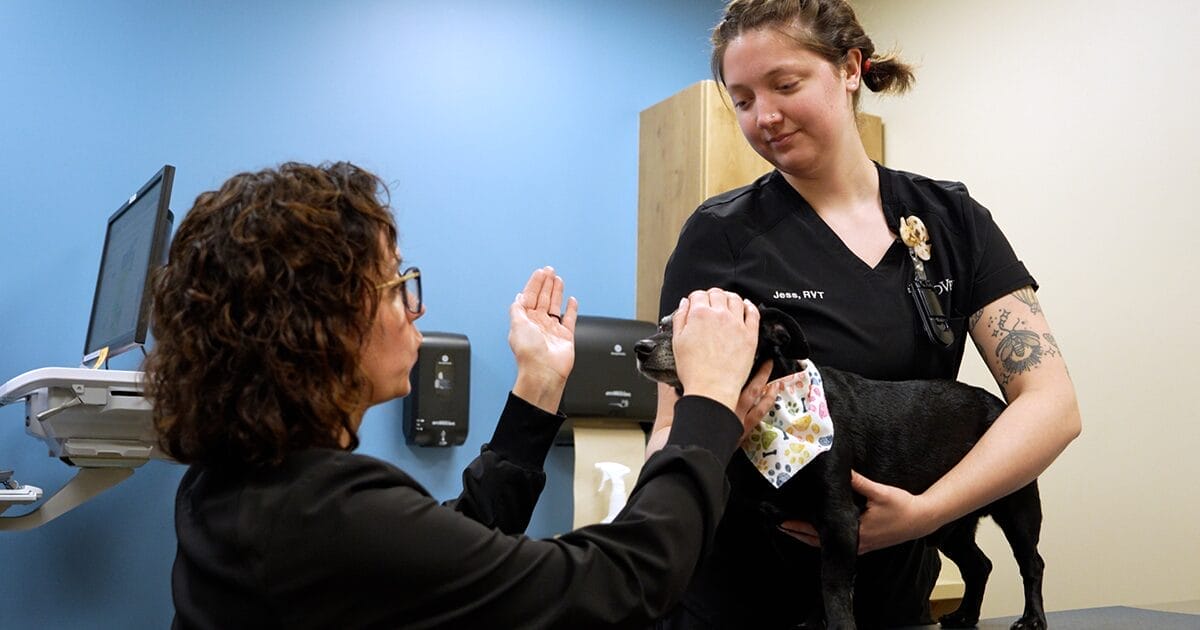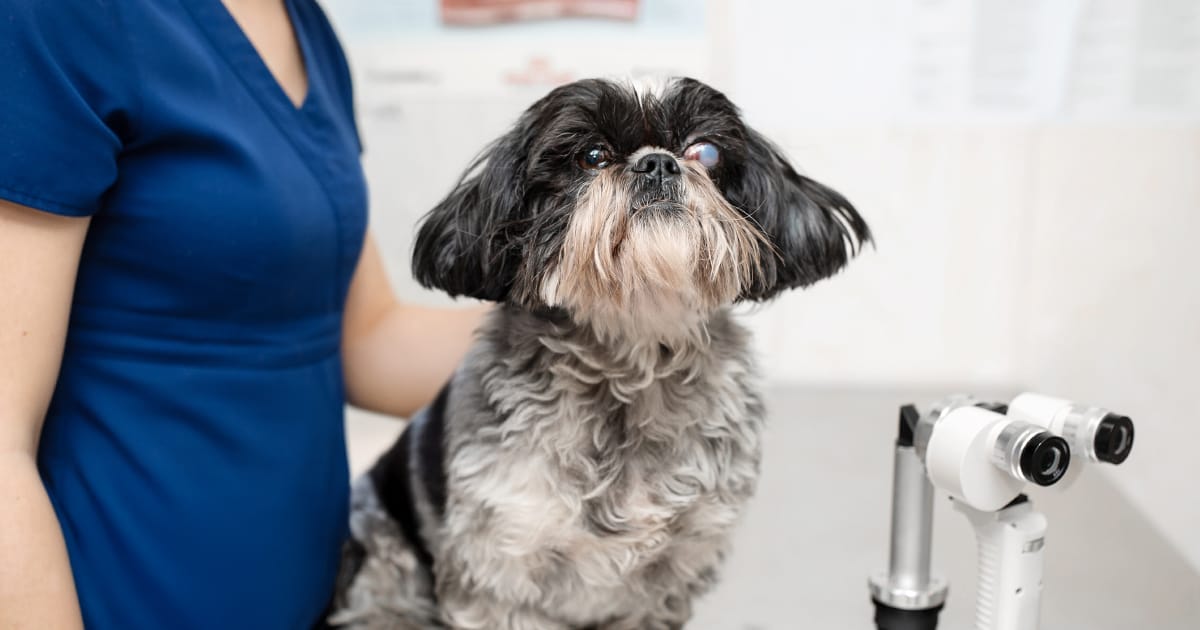
Uveitis in Dogs & Cats
Uveitis, an inflammation in the major structures of the eye, can be painful for dogs and cats. Learn causes and treatments.
Uveitis is a serious and often painful condition that affects the eyes of both dogs and cats. If left untreated, it can lead to complications like glaucoma, cataracts, or even blindness. Early diagnosis and treatment are essential for protecting your pet’s vision and quality of life. In this blog post, our board-certified ophthalmology specialists explain what uveitis is, its causes, signs to watch for, how it’s diagnosed, and the most effective treatment options available today.
What is Uveitis in Dogs and Cats?
Uveitis refers to inflammation of the uveal tract, which includes the iris, ciliary body, and choroid—the parts of the eye responsible for blood supply and nutrient exchange. Inflammation can affect just the front of the eye (anterior uveitis), the back (posterior uveitis), or both (panuveitis).
Uveitis is not a disease itself, but rather a sign of an underlying issue—ranging from infections to immune system disorders or even cancer.

Causes of Uveitis in Dogs and Cats
Uveitis in dogs can stem from a wide variety of causes, including:
- Tick-borne diseases: Lyme Disease, Ehrlichiosis, Rickettsia, Rocky Mountain Spotted Fever
- Fungal infections: Blastomycosis, Histoplasmosis, Cryptococcus, Coccidioidomycosis
- Parasite disease: Heartworm, intestinal parasites
- Immune-mediated diseases: Such as uveodermatologic syndrome
Certain dog breeds are more prone to developing uveitis. The Golden Retriever is one such breed, susceptible to Golden Retriever Pigmentary Uveitis, a condition that can lead to vision loss if left untreated. Other breeds may also be at risk due to genetic or immune-mediated factors. If you own one of these breeds, regular eye exams with a veterinarian are essential to detect and manage uveitis early. Learn more about what to expect during your pet’s eye exam in our blog post.
Uveitis in cats is often linked to infectious diseases, including:
- FELV (Feline Leukemia Virus)
- FIV (Feline Immunodeficiency Virus)
- FIP (Feline Infectious Peritonitis)
- Mycoplasma Haemominutum
- Toxoplasmosis
- Bartonella henselae (cat scratch disease)
- Fungal infections (similar to dogs)
- Cancer (especially lymphoma)
In many cases, particularly in cats, the underlying cause of uveitis remains unknown, and these instances are classified as idiopathic or immune-mediated.
Clinical Signs of Uveitis in Pets
Uveitis can be subtle at first. But as the inflammation progresses, your pet may show signs like:
- Squinting or blinking frequently
- Light sensitivity (photophobia)
- Redness in the white of the eye
- Cloudy or bluish appearance to the eye
- Small or irregular pupil (miosis)
- Blood or pus inside the eye (hyphema or hypopyon)
- Visible changes in iris color or shape
- Vision changes—your pet may bump into things or appear disoriented
If your pet displays any of these signs, seek immediate veterinary attention. Your primary care veterinarian may then refer you to a veterinary ophthalmologist, a specialist with advanced training in diagnosing and treating eye disorders.

Diagnosing Uveitis in Pets
Diagnosing uveitis in dogs and cats involves a combination of physical eye exams and identifying potential underlying causes. Because uveitis is often secondary to other diseases, identifying the root case is key to successful treatment.
To diagnose the underlying cause of your pet’s uveitis, your veterinarian may recommend a series of diagnostic tests. Here’s what you can expect:
Eye Exams: Your veterinarian will perform a thorough eye examination to check for signs of uveitis and rule out other conditions. This may include:
-
- Fluorescein staining to check for corneal ulcers
- Tonometry to measure the pressure inside your pet’s eye
- Slit lamp examination or ophthalmoscopy to examine the front and back of the eye
Blood Tests and Imaging: Your veterinarian may also recommend blood tests and imaging studies to check for underlying conditions that could be causing uveitis. These may include:
-
- Blood work (CBC and chemistry panel) to check for signs of infection or inflammation
- Urinalysis to check for kidney disease or other conditions
- Serology or titers to check for exposure to certain diseases (such as FeLV, FIV, fungal infections, tick-borne diseases, toxoplasmosis, Bartonella, and FIP)
- Chest X-rays and abdominal ultrasound to check for cancer or other internal diseases
- Ocular ultrasound or CT/MRI if cancer is suspected
Advanced Testing: In some cases, your veterinarian may recommend more advanced testing, such as:
-
- Aqueous or vitreous centesis (a procedure where a sample of fluid is taken from the eye) and cytology or antibody ratio testing (like the Goldmann-Witmer coefficient) to help diagnose certain conditions or rule out cancer.
- Ocular cytology, which involves examining cells from the eye to help diagnose conditions such as cancer or infection.
These diagnostic tests will help your veterinarian determine the underlying cause of your pet’s uveitis and develop an effective treatment plan.

Treatment for Uveitis in Dogs and Cats
The primary goals of treating uveitis are to relieve pain, reduce inflammation, prevent synechiae (abnormal iris tissue adhesions), minimize the risk of glaucoma (optic nerve damage), and address any underlying disease.
Local Therapies for Uveitis
- Topical Corticosteroids: Prednisolone acetate 1% or dexamethasone 0.1% are effective for treating anterior uveitis. However, they should be avoided if a corneal ulcer is present.
- Topical NSAIDs: Medications like diclofenac can be used if corticosteroids are contraindicated.
- Mydriatics/Cycloplegics: Atropine 1% can decrease inflammation and prevent synechiae. Use with caution if intraocular pressure (IOP) is elevated.
Systemic Therapies for Uveitis
- Systemic Corticosteroids: Prednisone or prednisolone can be used for posterior or severe inflammation, but not if a systemic infection is suspected.
- Systemic NSAIDs: Carprofen or meloxicam can be used if corticosteroids are contraindicated. However, oral steroids and NSAIDs should not be taken simultaneously.
- Antimicrobials: Systemic antibiotics or antifungals are used when an infection is suspected or confirmed.
While not commonly used, there are newer human immune-modulating therapies, such as cyclosporine implants, that have been used experimentally in animals, particularly in recurrent cases, to reduce relapse frequency and steroid dependence.
Monitoring and Follow-Up Care for Pets with Uveitis
Treating uveitis is a long-term process that often requires weeks or even months of medication. Your veterinarian will need to monitor your pet’s eye pressure and inflammation regularly, typically every 1-2 weeks initially. Once the inflammation is under control, the medication will be gradually tapered off to prevent rebound flare-ups.
Potential Complications to Watch For:
- Glaucoma
- Cataracts
- Retinal detachment
- Permanent blindness
- Shrinkage of the eye (phthisis bulbi)
Regular follow-up care is essential to manage these potential complications and ensure the best possible outcome for your pet.
Learn more about veterinary ophthalmology.
FAQs
What is uveitis in dogs and cats?
What are the signs of uveitis (eye inflammation) in dogs and cats?
How is uveitis in dogs and cats diagnosed?
How is uveitis treated in dogs and cats?
Learn More
Regular eye check-ups for your pet help maintain their eye health and detect any potential health issues.
Veterinary OphthalmologyContents
Learn More
Regular eye check-ups for your pet help maintain their eye health and detect any potential health issues.
Veterinary Ophthalmology


